#based on research
Text
doctor who episode where they meet sherlock and watson and the alien threat is described and angels and demons is this anything
#superwholock#posts that apparently would've sent people into hysterics in like. 2013#based on research
4 notes
·
View notes
Text
I created this story for you to read, not to scare you. This story is based on a true event that happened. I came across it on social media, so I searched for more details. I named this story 'The Haunted House' because it takes place in a haunted house. Just read it, I love you, and good morning to you!
‼️ ONE SHOT ‼️
‼️BASED ON TRUE STORY ‼️
‼️ EXPECT THERE'S A WRONG GRAMMAR OF THE STORY ‼️
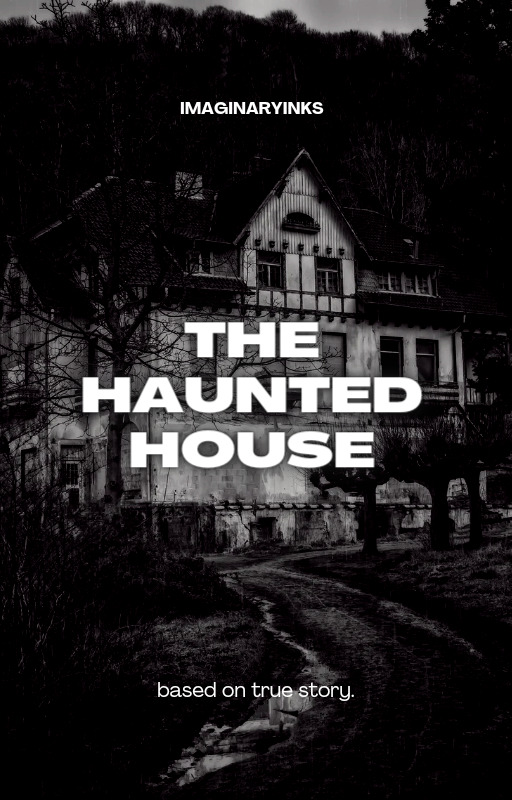
Once upon a time, in a small, secluded town, there was a dilapidated house that stood as a dark reminder of a gruesome past. The locals whispered of a chilling legend that surrounded this house, a story so terrifying that it sent shivers down their spines.
According to the tale, decades ago, a family had moved into the house, unaware of the horrors that awaited them. As the days turned into nights, strange occurrences began to unfold. The family would hear eerie whispers echoing through the halls, even when they were alone. Objects would move on their own, doors would slam shut without any wind, and the temperature would drop drastically, as if an unseen presence had taken over the house.
One fateful night, the family's young daughter, Sarah, went missing without a trace. The desperate parents searched every corner of the house, their hearts pounding with fear. As they reached the basement, they discovered a hidden secret room, covered in disturbing symbols and bloodstains. It seemed to be a place of unspeakable darkness and evil.
The parents, consumed by grief and terror, called upon a renowned paranormal investigator to uncover the truth behind their daughter's disappearance. Armed with his equipment, the investigator ventured into the haunted house, determined to confront the malevolent force that lurked within its walls.
As he delved deeper into the mysteries of the house, he encountered supernatural phenomena that defied logical explanation. Apparitions of the long-dead family members appeared before him, their faces twisted in anguish. The investigator heard agonizing screams that echoed through the night, leaving him paralyzed with fear. The house seemed to have a life of its own, preying on the living and trapping their souls within its cursed walls.
After weeks of relentless investigation, the truth finally unraveled. It was revealed that the house had once been a place of unspeakable horrors, where a deranged serial killer had conducted his gruesome acts. The restless spirits of his victims were trapped within the house, forever seeking justice and revenge.
The investigator, determined to bring peace to the tormented souls and the grieving family, performed a powerful cleansing ritual. As he chanted ancient incantations and banished the evil presence, the house trembled and shook, as if fighting against its own demise. In a blinding flash of light, the spirits were released, and the house fell into an eerie silence.
To this day, the haunted house stands as a chilling reminder of the horrors that occurred within its walls. The legend of the family and the paranormal investigator lives on, as a cautionary tale for those who dare to enter its sinister domain.
THE END
#zellyzel#hazel#au#imaginaryinks#story creator#based on true story#the haunted house#the#haunted#house#horror story#based on research#horror#own post#writters on tumblr#song writter#achievement#archive of our own#hazel cuizon#zel#cuizon#hazel dioquino cuizon#hazeltail#ImaginaryInk#not fiction#writeblr#zelink#hazel post#my post#horror history
5 notes
·
View notes
Text
By the way, I would literally bet money that we're going to successfully keep global warming below 2 degrees celsius.
Would I bet my whole savings on it? No, not yet. But the way the data is trending, in two or three years, I very well might.
#good numbers keep going up at a rate that is drastically higher than expected#and that rate is going to keep increasing#metaphorically ofc I don't gamble with that kind of money lol#but seriously#I WOULD bet money that we will keep the increase under two degrees celsius#based on all the news and articles I've seen and all the research I've done#SHOUTOUT TO EXPONENTIAL CURVES#COME SAVE OUR ASSES EXPONENTIAL CURVES#lay translation of that is#not news#climate change#climate anxiety#me#climate hope#global warming
2K notes
·
View notes
Text
DP x DC: The Most Dangerous Card Game
Ok so Danny has essentially claimed earth as his. And he is fully aware that there are constant threats to the planet. Now he can’t stop a threat that originates on earth (that’s something he’ll leave to the Justice league) but he can do something about outside threats. Doing some research on ancient spells, rituals, and artifacts, he cast a world wide barrier on the planet to protect it from hostile threats so they cannot enter. This will prevent another Pariah Dark incident. However, barriers like this come at a price. You see, there are two ways to make a barrier. Either make one powered up by your own energy and power (which would be constantly draining) or set up a barrier with rules. The way magic works is that nothing can be absolutely indestructible. It must have a weakness. The most powerful barriers weren’t the ones reinforced with layer after layer of protective charms and buffed up with power. Those could eventually be destroyed either by being overpowered, wearing them down, or by cutting off the original power source. No, the most powerful barriers were the ones with a deliberate weakness. A barrier indestructible except for one spot. A cage that can only be opened from the outside. Or that can only be passed with a key or by solving a riddle. So Danny chooses this type of barrier and does the necessary ritual and pours in enough power to make it. And he adds his condition for anyone to enter.
Now the Justice league? Find out about the barrier when Trigon attempts to attack, they were preparing after he threatened what he would do once he got to earth. How he would destroy them. The Justice league tried to take the fight to him first but were utterly destroyed, so they retreated home to tend to their injuries, and fortify earth for one. Last. Stand. Only when Trigon makes his big entrance…he’s stopped.
The Justice league watch in awe as this thin see-through barrier with beautiful green swirls and speckled white lights like stars apears blocking Trigon and his army’s advance. The barrier looks so thin and fragile yet no matter how hard the warlord hits, none of his attacks can get through and neither can he damage said barrier. That’s when Constantine and Zatanna recognizes what this barrier is. Something only a powerful entity could create. For a moment, the league is filled with hope that Trigon can’t get through yet Constantine also explains that it’s not impenetrable. And clearly Trigon knows this too for he calls out a challenge.
And that’s when, in a flash of light, a tiny glowing teenager appears. He looked absolutly minuscule compared to Trigon and yet practically glowed with power (this isn’t a King Danny AU though).
And that is when the conditions for passing the barrier are revealed. And the Justice realize that the only thing stopping Trigon and his army from decimating earth. The only way he can get through….is by beating this glowing teenager in a card game.
Not just any card game though. The most convoluted game Sam, Danny, and Tucker invented themselves. It’s like the infinite realms version of magic the gathering, combined with Pokémon, and chess. And Danny is the master. So sit down Trigon and let’s play.
(The most intense card game of the Justice league’s life).
After Danny wins, this happens a few more times with outer word beings and possibly even demons attempting to invade earth, yet none have been able to beat the mysterious teenager in a card game. Constantine might even take a crack at it and try to figure out how to play. He’s really bad though. Every time this happens, the Justice league worry that this might be the time the teenager looses. Yet every time, he wins (even if only barely).
Meanwhile, Danny, Sam, and Tucker have gotten addicted to the game and play it almost daily. Some teachers might seem them playing the game are are like ‘awww how cute’ not realizing this game is literally saving the world. Jazz is just happy they aren’t spending as much time on their screens playing Doomed.
#DPxDC#dcxdp#Danny makes a card game to save the world.#Technically he worded the ritual so that they had to ‘beat’ him as those are the most powerful barriers and most reliable.#keys can just get lost or stolen (like the one to Pariah’s Coffin)#A riddle would be useless once someone figured out the answer. Like how no one takes the sphynx seriously anymore.#(Sorry Tuck. But it’s true).#And there is NO WAY Danny is just leaving a hole open for anyone to pass through. No thank you!#So…beating him. But it’s not like Danny wanted to fight so…he edited the ritual a TINY bit. Card games are good. Much less painful too.#Danny Tucker and Sam made the most complicated card game they could imagine.#It’s based on their strategies for fighting ghosts. Capturing them in thermoses. And MUCH based on a on field battle strategy.#It often requires spontaneous thinking on the spot. So Danny? In his ELEMNT. It doubles as practice for his actual ghost battles too.#They had SO much fun making this.#Sam added an entire series of plant cards that act as traps and healing ointments and duds that just take up the field.#Tucker added legitimate hyroglyphics combined with Latin as well as English and ghost speak.#Yes. You actually have to speak that language to play. With proper pronunciation. (Amity Parker’s think the three are talking gibberish.)#I headcanon Sam and Tucker are fluent in Ghost.#Constantine WILL figure this game out SO HELP HIM!#Some of the cards also have combinations related to constellations either in name or placement on the board.#By the way the board is based on a Hexagonal summoning circle with Rhunes along the edges#And the placement of the cards on the board and on what rhune MATTERS.#Also the cards move disintegrate and have certain abilities. Think of Harry Potter Wizard Chess.#But they are normal when Danny plays at school. This is just for ✨effect✨ Against invaders.#Danny faces multiple opponents. He also halts alien invasions.#While Danny COULD stop crime on earth he’s not sure how to fight a normal human and hold back so he sticks to ghosts.#The Justice league are going crazy trying to figure out who this entity is and after deep research are convinced this is some sort of#Ancient being who has protected earth for millenia. They have paintings on ruins and everything.#Danny is not aware they think this.#Raven starts praying to Danny as if he is a god and wrangles the other Teen Titans into doing so as well. Danny is still unaware of this.#Danny is not a King or an ancient. Just a very VERY strong ghost.
2K notes
·
View notes
Text


Human sukuna sketches
Close ups:



#my head is rotted over his backstory#gege please. its a base need..#i did so much research about heian fashion#only to draw him shirtless 90% of the time#who needs historical accuracy when you have hot man#ryomen sukuna#jjk#jujutsu kaisen#jjk fanart#true form sukuna#heian era sukuna#i neglected to do college work for this
1K notes
·
View notes
Text

day 1421
#uh just a heads up if you expand the tags to see all there's. a lot. very long#amphibian#frog#poison dart frog#based on my most popular frog to date (day 651)#inspired by everyone pointing out what they think it looks like#here's a fun secret fact the original guy is actually a phantasmal poison dart frog (Epipedobates tricolor)#(according to the original artists title of the drawing)#not Anthony's poison arrow frog (Epipedobates anthonyi)#i feel too awkward to really point it out though because they look the exact same. i cannot tell if there is a difference#im half convinced the same frog was just discovered and named twice#its very curious btw if you go on the (english) wikipedia page for either species it doesn't mention the other#while hereptiles.info (no idea if this is a trustworthy site) lists both names as common names for the same frog (incorrectly??)#while inaturalist lists them as two different frogs. curiously with tricolor having wayyyyy fewer photos#ok anyway that's my rant i went on a whole journey trying to figure out if these are the same frog or not and i have no answer#i did some more 'research' and i am more confused. some sources seem to imply they are now considered the same species ( e. tricolor)#i think my conclusion is i am willing to agree the drawing looks more like e. anthonyi. it seems like tricolor is generally less vibrant re#and the white is darker and more green?#i feel like thumblr should stop me from typing more in the tags at this point this is a whole essay#at this point i am failry convinced this is specifically the Santa Isabel frog. isthat the real subspecies or morph or whatever#or just the name pet sites are using to sell it??#i even found some sources (frog selling websites) refering to it as “Epipedobates Anthonyi 'Santa Isabel' Phantasmal Poison Dart Frog” lol#Anyways if you read this far hi. species are confusing. i am not a frog scientist#the first few tags are like an hour old now i just kept trying to figure it out and adding more tags
2K notes
·
View notes
Text
The deeply moralist tone that a lot of discussions about media representation take on here are primarily neoliberal before they are anything else. Like the shouting matches people get into about “purity culture” “pro/anti” etc nonsense (even if I think it’s true that some people have a deeply christian worldview about what art ought to say and represent about the world) are downstream of the basic neoliberal assumption that we can and must educate the public by being consumers in a market. “Bad representation” is often framed as a writer’s/developer’s/director’s/etc’s failure to properly educate their audience, or to educate them the wrong way with bad information about the world (which will compel their audience to act, behave, internalise or otherwise believe these bad representations about some social issue). Likewise, to “consume” or give money to a piece of media with Bad Representation is to legitimate and make stronger these bad representations in the world, an act which will cause more people to believe or internalise bad things about themselves or other people. And at the heart of both of those claims is, again, the assumption that mass public education should be undertaken by artists in a private market, who are responsible for creating moral fables and political allegories that they will instil in their audiences by selling it to them. These conversations often become pure nonsense if you don’t accept that the moral and political education of the world should be directed by like, studio executives or tv actors or authors on twitter. There is no horizon of possibility being imagined beyond purchasing, as an individual consumer in a market, your way into good beliefs about the world, instilled in you by Media Product
#just saw a very stupid post. but I will endure#these discussions also remind me of anti-vaxxer discourse#which in North America for Covid is framed as simply wanting to make the best informed choice as a consumer in a market*#ideas about public goods or civic responsibility towards others are incompatible with this consumer-citizen view of the world#like legitimately the idea of the consumer as the base civic unit of north american society is catastrophic for public health#and produces these interminable discourses about ‘media consumption’#which itself is a neoliberal framing! I think ‘media’ as a catchall term is neoliberal because it links all art with the commonality of#being a good sold in a market#*outside of outright fascist anti-vax beliefs I should say. Although from my research so far these things seem to overlap heavily lol#which is not surprising but the distinction is worth teasing out#.txt
879 notes
·
View notes
Text
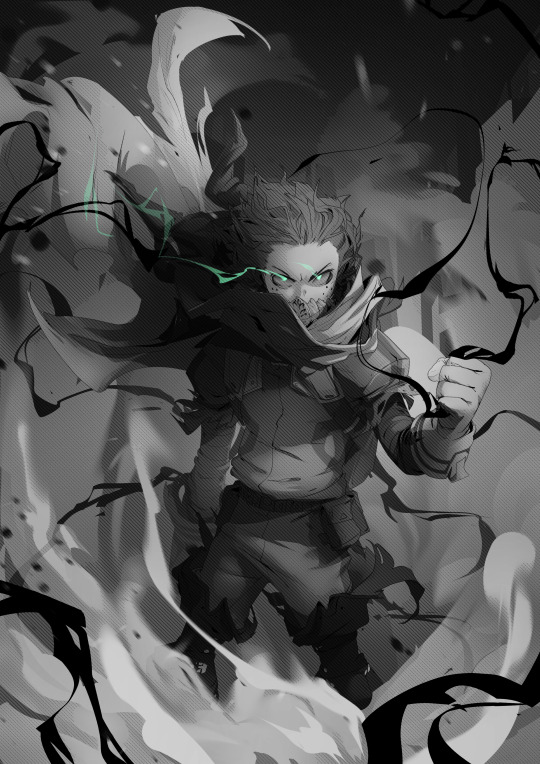
Been listening to 'drag me under' (vigilante deku song by divide music) and I realized I haven't drawn my all-time favorite version of Deku EVER in all the years I've been a fan ???
#bnha#midoriya izuku#izuku midoriya#bnha deku#mha deku#deku#vigilante deku#bnha fanart#mha fanart#fanart#also I havent actually caught up to the vigilante arc#neither in the manga or the anime#but I've researched enough to get it#also my preference is mostly based on how feral he looks#I didn't draw full beast deku#but honestly I love that version so much
774 notes
·
View notes
Text
doodling murderbot everyday until i get someone to read it - day 6
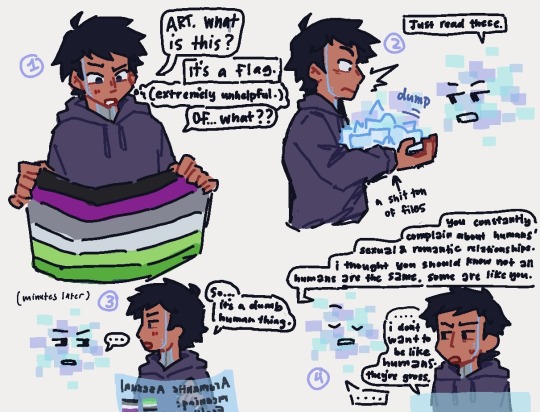
#murderbot#the murderbot diaries#asshole research transport#daily murderbot#i don’t actually think this is how it would go down..#i wrote a fic based on this but it’s currently unpublished#murderbot being aroace means so much to me actually#but i don’t think it would feel the same
646 notes
·
View notes
Text
Palantir’s NHS-stealing Big Lie
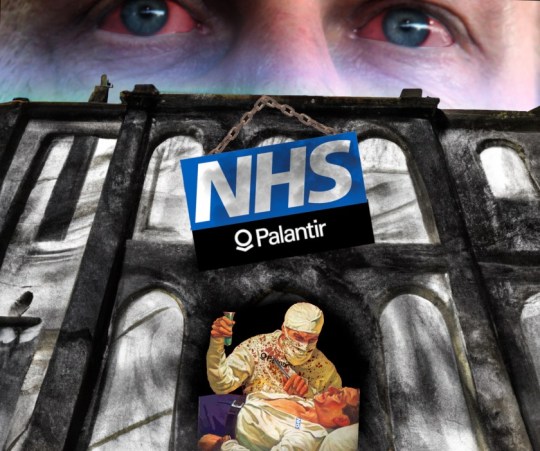
I'm on tour with my new, nationally bestselling novel The Bezzle! Catch me in TUCSON (Mar 9-10), then SAN FRANCISCO (Mar 13), Anaheim, and more!

Capitalism's Big Lie in four words: "There is no alternative." Looters use this lie for cover, insisting that they're hard-nosed grownups living in the reality of human nature, incentives, and facts (which don't care about your feelings).
The point of "there is no alternative" is to extinguish the innovative imagination. "There is no alternative" is really "stop trying to think of alternatives, dammit." But there are always alternatives, and the only reason to demand that they be excluded from consideration is that these alternatives are manifestly superior to the looter's supposed inevitability.
Right now, there's an attempt underway to loot the NHS, the UK's single most beloved institution. The NHS has been under sustained assault for decades – budget cuts, overt and stealth privatisation, etc. But one of its crown jewels has been stubbournly resistant to being auctioned off: patient data. Not that HMG hasn't repeatedly tried to flog patient data – it's just that the public won't stand for it:
https://www.theguardian.com/society/2023/nov/21/nhs-data-platform-may-be-undermined-by-lack-of-public-trust-warn-campaigners
Patients – quite reasonably – do not trust the private sector to handle their sensitive medical records.
Now, this presents a real conundrum, because NHS patient data, taken as a whole, holds untold medical insights. The UK is a large and diverse country and those records in aggregate can help researchers understand the efficacy of various medicines and other interventions. Leaving that data inert and unanalysed will cost lives: in the UK, and all over the world.
For years, the stock answer to "how do we do science on NHS records without violating patient privacy?" has been "just anonymise the data." The claim is that if you replace patient names with random numbers, you can release the data to research partners without compromising patient privacy, because no one will be able to turn those numbers back into names.
It would be great if this were true, but it isn't. In theory and in practice, it is surprisingly easy to "re-identify" individuals in anonymous data-sets. To take an obvious example: we know which two dates former PM Tony Blair was given a specific treatment for a cardiac emergency, because this happened while he was in office. We also know Blair's date of birth. Check any trove of NHS data that records a person who matches those three facts and you've found Tony Blair – and all the private data contained alongside those public facts is now in the public domain, forever.
Not everyone has Tony Blair's reidentification hooks, but everyone has data in some kind of database, and those databases are continually being breached, leaked or intentionally released. A breach from a taxi service like Addison-Lee or Uber, or from Transport for London, will reveal the journeys that immediately preceded each prescription at each clinic or hospital in an "anonymous" NHS dataset, which can then be cross-referenced to databases of home addresses and workplaces. In an eyeblink, millions of Britons' records of receiving treatment for STIs or cancer can be connected with named individuals – again, forever.
Re-identification attacks are now considered inevitable; security researchers have made a sport out of seeing how little additional information they need to re-identify individuals in anonymised data-sets. A surprising number of people in any large data-set can be re-identified based on a single characteristic in the data-set.
Given all this, anonymous NHS data releases should have been ruled out years ago. Instead, NHS records are to be handed over to the US military surveillance company Palantir, a notorious human-rights abuser and supplier to the world's most disgusting authoritarian regimes. Palantir – founded by the far-right Trump bagman Peter Thiel – takes its name from the evil wizard Sauron's all-seeing orb in Lord of the Rings ("Sauron, are we the baddies?"):
https://pluralistic.net/2022/10/01/the-palantir-will-see-you-now/#public-private-partnership
The argument for turning over Britons' most sensitive personal data to an offshore war-crimes company is "there is no alternative." The UK needs the medical insights in those NHS records, and this is the only way to get at them.
As with every instance of "there is no alternative," this turns out to be a lie. What's more, the alternative is vastly superior to this chumocratic sell-out, was Made in Britain, and is the envy of medical researchers the world 'round. That alternative is "trusted research environments." In a new article for the Good Law Project, I describe these nigh-miraculous tools for privacy-preserving, best-of-breed medical research:
https://goodlawproject.org/cory-doctorow-health-data-it-isnt-just-palantir-or-bust/
At the outset of the covid pandemic Oxford's Ben Goldacre and his colleagues set out to perform realtime analysis of the data flooding into NHS trusts up and down the country, in order to learn more about this new disease. To do so, they created Opensafely, an open-source database that was tied into each NHS trust's own patient record systems:
https://timharford.com/2022/07/how-to-save-more-lives-and-avoid-a-privacy-apocalypse/
Opensafely has its own database query language, built on SQL, but tailored to medical research. Researchers write programs in this language to extract aggregate data from each NHS trust's servers, posing medical questions of the data without ever directly touching it. These programs are published in advance on a git server, and are preflighted on synthetic NHS data on a test server. Once the program is approved, it is sent to the main Opensafely server, which then farms out parts of the query to each NHS trust, packages up the results, and publishes them to a public repository.
This is better than "the best of both worlds." This public scientific process, with peer review and disclosure built in, allows for frequent, complex analysis of NHS data without giving a single third party access to a a single patient record, ever. Opensafely was wildly successful: in just months, Opensafely collaborators published sixty blockbuster papers in Nature – science that shaped the world's response to the pandemic.
Opensafely was so successful that the Secretary of State for Health and Social Care commissioned a review of the programme with an eye to expanding it to serve as the nation's default way of conducting research on medical data:
https://www.gov.uk/government/publications/better-broader-safer-using-health-data-for-research-and-analysis/better-broader-safer-using-health-data-for-research-and-analysis
This approach is cheaper, safer, and more effective than handing hundreds of millions of pounds to Palantir and hoping they will manage the impossible: anonymising data well enough that it is never re-identified. Trusted Research Environments have been endorsed by national associations of doctors and researchers as the superior alternative to giving the NHS's data to Peter Thiel or any other sharp operator seeking a public contract.
As a lifelong privacy campaigner, I find this approach nothing short of inspiring. I would love for there to be a way for publishers and researchers to glean privacy-preserving insights from public library checkouts (such a system would prove an important counter to Amazon's proprietary god's-eye view of reading habits); or BBC podcasts or streaming video viewership.
You see, there is an alternative. We don't have to choose between science and privacy, or the public interest and private gain. There's always an alternative – if there wasn't, the other side wouldn't have to continuously repeat the lie that no alternative is possible.

Name your price for 18 of my DRM-free ebooks and support the Electronic Frontier Foundation with the Humble Cory Doctorow Bundle.

If you'd like an essay-formatted version of this post to read or share, here's a link to it on pluralistic.net, my surveillance-free, ad-free, tracker-free blog:
https://pluralistic.net/2024/03/08/the-fire-of-orodruin/#are-we-the-baddies

Image:
Gage Skidmore (modified)
https://commons.m.wikimedia.org/wiki/File:Peter_Thiel_(51876933345).jpg
CC BY-SA 2.0
https://creativecommons.org/licenses/by-sa/2.0/deed.en
#pluralistic#peter thiel#trusted research environment#opensafely#medical data#floss#privacy#reidentification#anonymization#anonymisation#nhs#ukpoli#uk#ben goldacre#goldacre report#science#evidence-based medicine#goldacre review#interoperability#transparency
520 notes
·
View notes
Note
Do you know why dogs do that little exhausted sigh when they lie down even when they haven't really done anything that particular day?
I, too, make exhausted little sighs when I flop down and am suddenly extremely comfy!
But, okay, here's what super interesting. I didn't want to just give you a flippant answer, so I started looking up if sighing is a behavior in other species than humans. Because it's always worth keeping an eye out for accidental anthropomorphism. Turns out? The science on sighing is fascinating. Stay tuned for intense nerding out, and maybe a bit more of an answer.
First off, we gotta know what a sigh is.
"The sigh is a deep augmented breath with distinct neurobiological, physiological, and psychological properties that distinguish it from a normal eupneic breath. Sighs are typically triggered by a normal eupneic breath and are followed by a respiratory pause, which is referred to as 'postsigh apnea.'"
In non-jargon, that definition means sighs are a deep breath with a different pattern to it than normal, easy, regular breathing. "Augmented breaths" are frequently used as a synonym for "sighs", and the best definition I found is that "they comprise prolonged inspiration and increased tidal volume followed by a respiratory pause and several seconds of faster breathing. So a longer than normal inhale where you take in more air than normal, then an exhale, and then pause before breathing in again. Oh hey, look, I found a graph!

The graph is super well labeled, but just to be clear: each cycle of the red line is a normal breath, where what's being tracked is the movement of the chest wall. The part where the vertical blue bar is, that's the cycle with a sigh. The red line spikes really high (during inspiration, or breathing in) at that blue patch, and for longer than the normal period of a breath. See how it's almost like two inhales on top of each other - a normal slope and then another upward spike? That's the "augmentation" of the normal breath, almost a double inhale without breathing out in-between. Then, after the red line drops (on the exhale) there's a flat bit. That's the respiratory pause, which the period after the sigh where you wait before you inhale again.
Apparently people have been tracking sighing scientific for like, over 100 years. The first record of it in academic literature was in 1919. And we know some really cool stuff. All humans sigh spontaneously. Even babies sigh! They do it every few minutes, whereas it's less frequent but still pretty regular in adults: one study found about once every five minutes, or twelve sighs an hour.
Okay, but why do we sigh? We only sort of know, because there's a bunch of different things that have to be studied to answer that question. The direct physiological aspect of it is the most well known at this point. You've got lots of little sacs lining your lungs, called alveoli, that facilitate gas transfer from the air you breathe into your blood. They make sure oxygen goes in and carbon dioxide gets breathed out. But sometimes they collapse and deflate, which prevents them from doing their job. When you do a big sigh, the air quantity in your lungs ends up being double that of normal, which inflates them again. So sighing is a way of doing lung maintenance, in a sense.
But there's so much more going on when you sigh than just that! This is the stuff researchers are still working on. They've got some pretty solid conclusions to start, but they're very emphatic that there's a ton more to learn.
Basically, the main hypothesis right now is that sighing functions as a "reset" for your internal state when it's out of balance. People sigh more when they're acutely anxious or stressed, are anticipating a negative outcome like a shock or seeing a negative image, or have chronic anxiety, PTSD, or panic disorders. Higher sigh frequency is also associated with pain: people with chronic low back pain sigh more, and how much they do correlates with how high their pain rating is at the time!
Another aspect of sighing is that it's frequently associated with periods of relief. Studies have noted that people sigh when they're able to relax following tension, like if they're interrupted while trying to do something really mentally taxing, when they finish a task that took a lot of attention for a long time, or if a negative stimulus stops/goes away. The reason behind that is actually thought to be why people sigh so much when they're upset or in pain: sighing doesn't just signal relief, but actually cause it! Some studies have found that people experience a temporary reduction in muscle tension right after a spontaneous sigh. (Unfortunately, that doesn't seem to also happen when you sigh on purpose.)
Sighing is also thought to facilitate behavioral and emotional transitions. The frequency at which someone sighs changes even just when they transition from sitting to lying down. People frequently sigh right before they fall asleep or start to wake up. One study found that people sigh more frequently when they go from a situation of being unable to anticipate what's next to a situation where they know what the outcome will be - regardless of if that outcome is going to be negative or positive! That led the researchers to hypothesize that sighing functions as an emotional reset from states of high internal arousal (a word which here means "the state of feeling awake, activated, and highly reactive to stimuli.") So sighing might not just bring relief when something really intense ends, but it might also help people prepare for upcoming stress.
Basically, researchers think that sighing may contribute to what they call "psychophysiological flexibility." That means that sighing helps keep someone in a physiological and emotional state that matches the situation they're in, and helps the body and mind adapt quickly when something changes. They noted that these types of transitions may involve "anticipatory, activation or recovery responses." In other words: they think spontaneous sighing is relevant not only when you're worried about encountering a leopard in the bush, but when you have to hide from the leopard you tripped over, and then also when you're calming down after the leopard got bored and left.
There's a whole bunch of research left to do about how exactly spontaneous sighs do what they do, but there's also a whole other aspect of the behavior that hasn't really been studied yet: their social function! In humans audible sighing is a salient social signal. (The researchers said the part of the paper addressing this that it is a "lay belief" that sighs have a "communicative function to convey emotions," which makes the whole thing feel like it was written by aliens observing humans from afar). But they did note that sighs for social communications may be totally different from other types of sighs, since the exhalation is often very exaggerated and doesn't always occur in tandem with that "augmented" inhale pattern that spontaneous sighs have.
Okay. So. I've been a nerd forever, but what about doggo sighs? Why do they occur? Obviously, the research doesn't give us a direct answer. The majority of the behavioral / situational research on sighing has been done on people, not animals. But it's pretty well documented lots of animals sigh (it might even be all mammals, I just don't have a citation for that). And some of the studies that have been done on animals indicated that they, too, sigh in relief when negative situations end or unpleasant stimuli go away.
Let's go back to my joke at the beginning of this book I've written. My first instinct was to be like "who doesn't sigh in relaxation when they finally get a chance to rest their bones?" That totally matches what's in the research: getting a chance to rest after activity is often both a behavioral transition and an emotional one, and if there's any physical discomfort being experienced, physical rest is often is a relief.
It seems fairly probable that dogs sigh when they lay down for at least one of those reasons. I can't prove that hypothesis, but it tracks with what the science says so far. The situation you described meets the main identified criteria for sighing: there's the physical transition of laying down, the behavioral/emotional transition of being ready for a period of low/no activity, and the possible relief of pain or discomfort that comes with laying down. We don't have any any evidence (that I was able to find) of species that sigh for other reasons, or sigh in situations that don't meet those criteria. We don't know for sure that this is accurate - this isn't fact, simply my educated guess. But since sighing seems to help muscles relax and relief discomfort, it seems reasonable to me that a good old sigh after the relief of laying down would make the transition to a resting state feel even better.
Sources:
Effects of the hippocampus on the motor expression of augmented breaths
Brainstem activity, apnea, and death during seizures induced by intrahippocampal kainic acid in anaesthetized rats
The Integrative Role of the Sigh in Psychology, Physiology, Pathology, and Neurobiology
Sigh rate during emotional transitions: More evidence for a sigh of relief
The psychophysiology of the sigh: I: The sigh from the physiological perspective
The psychophysiology of the sigh: II: The sigh from the psychological perspective
Affect Arousal
UCLA and Stanford researchers pinpoint origin of sighing reflex in the brain
#science!#dog behavior#sighing#sighs#I want to emphasize this is a hypothesis based on the existing body of research and that I am not an expert in this field#there are times where it is reasonable to look at the existing literature and create theories based on a synthesis of their findings#but this is not something to repeat as known fact#and that differentiation is extremely important in this sort of forum
3K notes
·
View notes
Text
I want to share this story with you so you can know about this story called 'The Haunting of Blackwood Manor.' Just read it, and there are more details in it. It's based on a true story. I researched more about that.
‼️ ONE SHOT ‼️
‼️BASED ON TRUE STORY ‼️
‼️ EXPECT THERE'S A WRONG GRAMMAR OF THE STORY ‼️

In the quiet town of Blackwood, nestled deep within the dense forest, stood an imposing Victorian mansion known as Blackwood Manor. The moment you laid eyes on it, an eerie chill ran down your spine. The locals whispered stories of a dark presence that haunted the halls, and many believed the house was cursed.
Legend had it that the mansion was built on an ancient burial ground, disturbed when the construction began. The restless spirits of the deceased were said to roam the halls, seeking revenge for their disturbed slumber.
The first family to move into Blackwood Manor was the Thompsons. John Thompson, a successful businessman, saw the grandeur of the mansion as an opportunity for a fresh start. He moved in with his wife, Sarah, and their two young children, Emily and Michael.
At first, everything seemed normal. But as the days turned into weeks, the Thompsons began to experience strange occurrences. Objects moved on their own, whispers echoed through the empty rooms, and cold drafts swept through the house even on the warmest of days.
Sarah, a skeptic by nature, tried to dismiss these incidents as mere coincidences. However, she couldn't deny the growing feeling of unease that settled upon her family. Emily and Michael, once cheerful and carefree, became withdrawn and fearful.
One night, as the family gathered for dinner, they heard a loud crash coming from the second floor. John rushed upstairs to investigate, only to find that the antique mirror in the hallway had shattered into countless pieces. No explanation could be found for this bizarre event.
As the days went by, the activity in the house escalated. Shadowy figures appeared in the corners of their vision, fleeting glimpses of faces twisted in anguish. Unexplained footsteps echoed through the halls at night, growing louder and more menacing with each passing hour.
Sarah, desperate to protect her family, sought the help of paranormal investigators. They conducted numerous experiments, capturing chilling evidence of the supernatural. Electronic voice phenomena whispered chilling messages, and thermal imaging cameras revealed icy handprints on the walls.
The investigators delved deeper into the history of Blackwood Manor and discovered a horrifying truth. The mansion had once been home to a notorious serial killer, who had lured innocent victims into his lair and tortured them to death. The spirits of these victims, trapped within the walls of the house, sought vengeance against anyone who dared to occupy their domain.
As the Thompsons learned the dark history of their home, they made a decision. They would not be driven out by fear. Instead, they would confront the spirits head-on and put an end to their torment.
With the help of a seasoned medium, they performed a ritual to communicate with the restless souls. Through séances and intense spiritual energy, they were able to make contact with the spirits and understand their pain. They offered prayers and forgiveness, releasing the trapped souls from their eternal torment.
Gradually, the activity in Blackwood Manor subsided, and a sense of peace settled upon the house. The Thompsons, forever changed by their ordeal, chose to stay in the mansion, determined to create a new beginning and heal the wounds of the past.
‼️ THAT'S ALL WHAT I RESEARCH FOR ‼️
#zellyzel#hazel#imaginaryinks#story creator#au#based on research#based on true story#song writter#writters on tumblr#writeblr#hazel cuizon#zel#zelink#hazeltail#hazel dioquino cuizon#cuizon#dioquino#horror story#about horror#achievement#archive of our own#own post#horror history#horror life#song writing#the haunting blackwood manor#the#haunting#of#blackwood
2 notes
·
View notes
Text
Spiders, their senses, and Angel Dust implications
I already screamed to @xxqueenofdragonsxx about this but figured I’d put it out there because I was doing research and I can’t stop thinking about it.
While we don’t know how canon it is to the show, this does have some implications for fanfics and is fun to consider.
Spiders don’t have ears. Or noses. Or tongues.
People have already made jokes about Angel’s lack of a nose, but it tracks with that fact. We also don’t see his ears, although we have seen his tongue (which, given he isn’t an actual spider there can be some allowances made.) Yes, he doesn’t have pedipalps to act as a substitution for his nose/tongue, but that isn’t the only place they can smell/taste things.
It’s their legs/feet(?). Their legs and bodies have sensory hair cells that allows them to detect vibrations in the air, as well as changes in electrical fields (which… Vox and Alastor implications? Can Angel sense them.) Humans hear via sensory hair cells too, but those are concentrated in the cochlea of the inner ear and surrounded by the outer/middle ear system (eardrum, etc.) Spiders don’t have that. They also have chemoreceptors that can smell and taste things.
Now, as someone who didn’t know much about spiders it’s cool to think about in terms of a character with some spider-like characteristics. But then I thought about this other aspect of Angel
His clothing
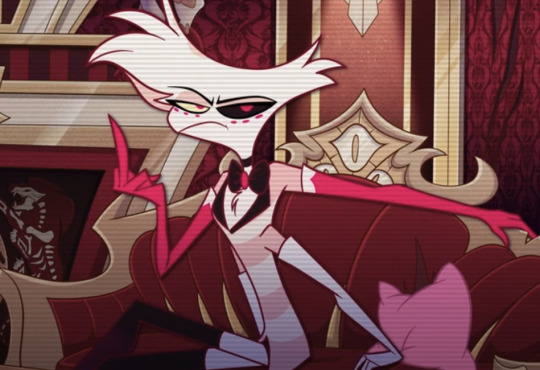
More specifically his constant usage of gloves/long sleeves/boots. We know he hates his spider feet, and yeah, the usage of gloves and his blazer can be to fit his style, but it’s also fun to think that maybe him wearing them is an active attempt to reduce sensory input? He’d still get some vibration input because the fabric won’t block everything, but it won’t be as direct. But since spider sensory organs aren’t localized like humans are, this could essentially be the equivalent of wearing a headphones. (Also do you really want to taste every single thing you touch?)
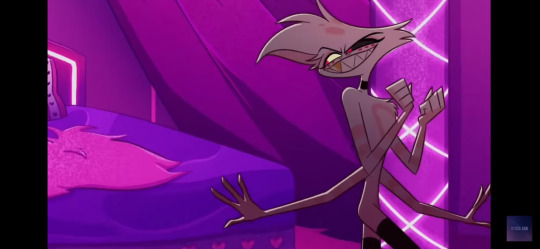
Which brings me to the second order of business: when he DOESNT wear his gloves. We do see him have to be bare for the camera, and if you consider him wearing clothes as a way of sensory modulation, he could essentially be forced to get all that input. Sensory overload would already be so ways in a place with so many sounds, lights, smells, etc. but imagine if you also have to do that when not used to such a level of exposure?
In humans there’s a condition called hyperacusis, which is basically a reduced pain and discomfort threshold to sounds. Some everyday ones can cause pain. Some neurodivergent people also have sensory sensitivities like that, in both cases sometimes headphones can help to reduce input.
The thing is though, if you constantly wear them you’re reducing your own threshold. It’s not recommended for people with hyperacusis to wear earplugs all the time because it makes them even more sensitive when not wearing them.
So, if you apply the same principle here, there is even more reason to consider the idea Angel would have some level of overstimulation just from not having his clothes on, combine that with the work environment, what he has to do, and the emotional turmoil of it all and that just makes it worse.
Which… with me anyways I’ve found when I’m too overloaded my brain tends to nope out and dissociate. So that could be what happens to Angel as well.
Then, there is one time outside of the studio we see him with uncovered arms and that’s the battle at the hotel.
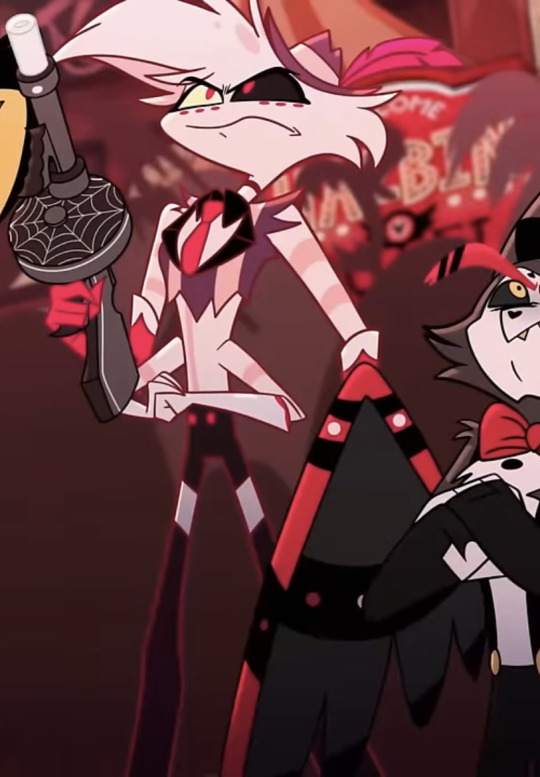
Here, he’s wearing gloves but his arms are exposed. So it could be said that he’s allowing himself access to more input while also not overwhelming himself. He still has a buffer with the gloves on, but he also has heightened awareness for things around him.
Again, the amount of this actually being applicable in canon is hard to say. Sense we don’t know how spidery Angel really is (since again, he does have a tongue) and what level of research went into that aspect of their character designs. But I think it’s a fun thing to consider.
So uhhh… yeah. Totally normal about this all as someone who totally isn’t interested in audiology, hyperfixating on hazbin hotel, and neurodivergent myself.
(Update: there is now a fic)
#I would like to state that this post is based on 2 am research of jumping spiders and spiders as a wholes sensory perception#so if there is any wrong information feel free to correct me#excuse me while I combine my special interests in a post#hazbin hotel#angel dust#angel dust hazbin hotel#hazbin hotel headcanon#hazbin hotel analysis#hazbin hotel meta
232 notes
·
View notes
Text
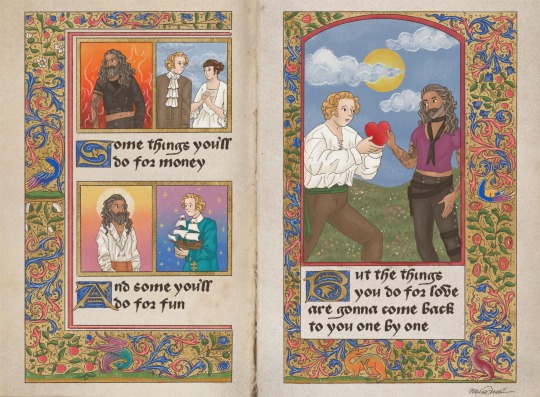


back from my hermitage to drop off more medievalisms, here you go besties (prints)
#i think this is the best thing i’ve ever made tbh#i did actual research and based it off of a real book of hours. down to the script even#anyway. back to my hermitage byeeee#ofmd#our flag means death#my art
581 notes
·
View notes
Text

food...
#ff14#ffxiv#finalfantasyxiv#finalfantasy14#food#food art#thavnair#im going based off my own research and understanding of indian Muslim as well as turkish cuisine#so i hope i got it right
827 notes
·
View notes
Text

Biblically accurate skizz
+ the sketch that inspired it

I really love the idea of skizz being an angel and wanted to give him a more clearly-not-human-but-still-humanoid-form.
The sketch being his way of presenting in front of others, with a glamour that makes him look just like a normal avian, the halo being the only give away for his angelic origin.
My plan was for his true form to be inspired by thrones since they are angels of mercy that reflect (God's) unconditional love. But I wanted him to still look like skizz, and thrones are literal wheels with many eyes. So I decided he should get two crossing halo's that would move like wheels to still have that important detail (I like the interpretation that the crossing wheels of thrones symbolise the connection between all of creation).
I still like that idea, so I decided that it could be like a form between his guardian angel glamour and his actual throne form
(this is kind of all over the place but i really wanted to share a bit of my thought process on this)
#skizzleman#skizzleman fanart#hermitcraft season 10#hermitcraft fanart#hermitcraft#The base idea was just the scars being closed eyes#and then i started some research on the christian angel hierachy#and now this exists#tw eye horror#cw eye horror#my art
204 notes
·
View notes